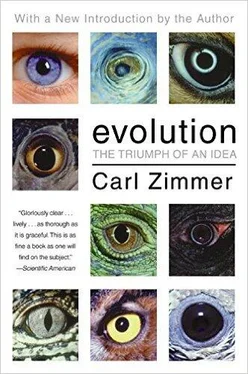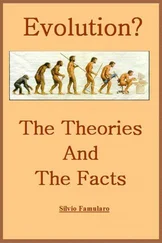The best evidence came not from the rocks themselves but from the fossils that they encased. In France, for example, a young paleontologist named Georges Cuvier compared the skulls of living elephants to the fossils of elephants that had been unearthed in Siberia, Europe, and North America—all places where no elephants are found today. Cuvier sketched out their massive jaws, their teeth fused together into corrugated slabs. He demonstrated that the fossil elephants (called mammoths) were fundamentally different from those alive today—“as much as, or more than, the dog differs from the jackal and the hyena,” he wrote. It would be hard to claim that such a distinctive giant was wandering around without anyone noticing it. For the first time, a naturalist had shown that species had become extinct in the past.
Cuvier went on to demonstrate that many other mammals had gone extinct as well. His discoveries, he wrote, “seem to me to prove the existence of a world previous to ours, destroyed by some kind of catastrophe. But what was this primitive earth? What was this nature that was not subject to man’s dominion? And what revolution was able to wipe it out, to the point of leaving no trace of it except some half-decomposed bone?”
Cuvier went even further. There had not been a single catastrophe that had wiped out mammoths and other extinct mammals, but a whole series of them. The fossils of the different ages were so distinct that Cuvier could even use them to identify the rock formation where they had been found. Exactly what had caused the catastrophes Cuvier didn’t know for sure. He speculated that revolutions might be caused by a sudden rise of the ocean or a drastic cold snap. Afterward, new animals and plants appeared either by migrating from elsewhere on the planet or by being somehow created. But Cuvier was sure of one thing: revolutions were common in the history of Earth. If Noah’s Flood was real, it had been only the most recent in a long succession of catastrophes; each had wiped out a slew of species, and most had taken place long before humans existed.
To work out the true pace of life’s history, British geologists such as Adam Sedgwick set out to chart the entire geological record of the planet, layer by layer. The names they gave to the formations, names like the Devonian and the Cambrian are still used today. But while British geologists in the early 1800s were a long way from a literal reading of the Bible, they still saw their work as a religious calling. They were convinced their science could reveal God’s work—even His intentions. Sedgwick himself referred to nature as “the reflection of the power, wisdom, and goodness of God.”
Manifestations of Design
For British researchers such as Sedgwick, God’s goodness was visible not just in the way He created Earth, but in the way He brought life into existence. Each species had been created separately and had been unchanged ever since. Yet species could also be grouped together—into categories such as plants and animals, and within them, into smaller categories such as fishes and mammals. This pattern, British naturalists believed, reflected God’s benevolent plan for the world. It was organized as a gradation that started with inanimate objects and the slimy forms of life and reached up toward higher and higher forms—“higher” defined, of course, as being more like humans. Not a single link in this Great Chain of Being could have ever changed, for that would mean that God’s creation had been imperfect. As Alexander Pope once wrote, “From Nature’s chain whatever link you strike/Tenth, or ten thousandth, breaks the chain alike.”
Not only did the Great Chain of Being reveal God’s benevolent handiwork, but so did the exquisite designs of individual species—whether you considered a human’s eye or a bird’s wing. William Paley, an English parson, laid out this argument in books that were mandatory reading for Darwin and other aspiring naturalists and theologians at Cambridge.
Paley’s argument centered on a seductive analogy. “In crossing a heath,” he wrote, “suppose I pitched my foot against a stone and were asked how the stone came to be there.” It might, for all Paley knew, have lain there forever. “But suppose I had found a watch upon the ground, and it should be inquired how the watch happened to be in that place.” In that case, Paley argued, he would come to a very different conclusion. Unlike a stone, a watch is made of several parts that work together for a single purpose: to mark the passing of time. And these parts can work only if they work together; half a watch cannot tell time.
The watch therefore must have been created by a designer. Paley could say this even if he didn’t know how to make a watch, and even if the watch he found was broken. To say that it was just one of many different possible combinations of bits of metal would be absurd.
When we look at nature, Paley argued, we find countless creations far more intricate than a watch. Telescopes and eyes are built on the same principle, with lenses that bend light in order to create an image. In order to bend light in water, a lens has to be rounder than it would be in air. Lo and behold, the eyes of fishes have rounder lenses than those of land animals. “What plainer manifestation of a design can there be than this difference?” Paley asked.
An oyster, a spoonbill, a kidney: anything Paley examined showed him that nature had a designer. The laws of physics, which astronomers were using at the end of the 1700s to describe the orbits of the planets, may have taken away some of the glory of God. (“Astronomy,” Paley admitted, “is not the best medium with which to prove the agency of an intelligent creator.”) But life was still fertile theological ground.
From nature, Paley deduced not only the existence of a designer, but that He was benevolent. In the vast majority of cases, he argued, the contrivances of God were beneficial. What little harm there was in the world was just an unfortunate side effect. A person might use his teeth to bite someone, but they were actually designed so that he could eat. If God had wanted us to cause each other harm, He could have designed much better weapons to put in our mouths. These sorts of shadows couldn’t distract Paley from the sunshine of life: “It is a happy world after all. The air, the earth, the water teem with delighted existence.”
How the Giraffe Got Its Neck
Darwin was impressed by Paley’s rhetoric, but at the same time he was also vaguely aware of some less respectable ideas about how life came to take its current form. Some of them came from his own family. His grandfather, Erasmus Darwin, had died seven years before Charles was born, but even in death he was impossible to ignore. A doctor by trade, he was also a naturalist, an inventor, a botanist, and a best-selling poet. In one of his poems, entitled The Temple of Nature, he argued that all animals and plants now living were originally derived from microscopic forms:
Organic Life beneath the shoreless waves
Was born and nurs’d in Ocean’s pearly caves;
First forms minute, unseen by spheric glass,
Move on the mud, or pierce the watery mass;
Then as successive generations bloom,
New powers acquire and larger limbs assume.
Erasmus Darwin’s personal life was as scandalous as his scientific views. After the death of his first wife, he began reveling in natural love, fathering two children out of wedlock. “Hail the Deities of Sexual Love!” he declared, “and sex to sex the willing world unite.” His son Robert always considered Erasmus something of an embarrassment, and so his grandson Charles, growing up at the tranquil, proper Mount, did not learn much about him.
Читать дальше












